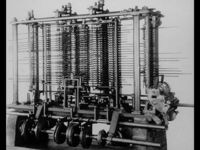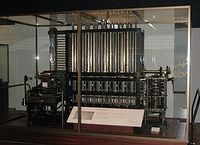Difference between revisions of "Computer"
m (cleaning) |
(added kinds section) |
||
| Line 1: | Line 1: | ||
A '''computer''' is a machine that is designed to perform a huge variety of information-processing tasks, depending on the program it has stored in its memory. Computers manipulate all data in the form of numbers, and encode all numbers in [[binary|binary code]], which is base 2. This means that there can only be a 1 or a 0 in any data. This makes it possible to process data electronically, since one voltage can be used to represent a zero and another voltage for a one. | A '''computer''' is a machine that is designed to perform a huge variety of information-processing tasks, depending on the program it has stored in its memory. Computers manipulate all data in the form of numbers, and encode all numbers in [[binary|binary code]], which is base 2. This means that there can only be a 1 or a 0 in any data. This makes it possible to process data electronically, since one voltage can be used to represent a zero and another voltage for a one. | ||
| − | + | ==History== | |
[[Image:Babbage.jpg|right|thumb|200px|Contemporary (1800's) illustration of what Charles Babbage's Difference Engine might have looked like.]] | [[Image:Babbage.jpg|right|thumb|200px|Contemporary (1800's) illustration of what Charles Babbage's Difference Engine might have looked like.]] | ||
| Line 12: | Line 12: | ||
[[File:SSEM Replica.jpg|thumb|left|The Manchester Small-Scale Experimental Machine is considered the world's first stored-program computer, 1948.]] | [[File:SSEM Replica.jpg|thumb|left|The Manchester Small-Scale Experimental Machine is considered the world's first stored-program computer, 1948.]] | ||
The first computer comparable to the modern day computer, an electronic calculation machine, was the [[ENIAC]]. Built as a artillery support machine, it was unveiled in early 1946.<ref>http://ftp.arl.army.mil/~mike/comphist/</ref> | The first computer comparable to the modern day computer, an electronic calculation machine, was the [[ENIAC]]. Built as a artillery support machine, it was unveiled in early 1946.<ref>http://ftp.arl.army.mil/~mike/comphist/</ref> | ||
| − | + | ==Kinds== | |
| + | Computers are divided into four categories. They are: personal computers, mainframe computers, dedicated computers, and embedded computers. | ||
| + | ===Personal computers=== | ||
| + | Personal computers are ones designed for use by a single user at any given time. These are the common desktop and laptop computers most people use today. Tablet computers could also be included in this general category. Some businesses will include person computers in a client-server network. In this system, the personal computers are used to connect with a main server computer (or in some cases, a server cluster).<ref name="WorldBook01">The World Book Encyclopedia. 2001 ed. Vol. 4. Chicago: World Book, 2001. Print. Pages 908-94</ref> | ||
| + | ===Mainframes=== | ||
| + | Mainframes were the first kind of computers, and always used to be the fastest option. They had the ability to process much more information at a faster rate than any other kind).<ref name="WorldBook01">The World Book Encyclopedia. 2001 ed. Vol. 4. Chicago: World Book, 2001. Print. Pages 908-94</ref> However, with the rapid advancement of technology in recent years, these have become largely obsolete. Since the modern laptop has more processing power than a mainframe of the 1990s, there is little point for the continued use of them. Mainframes also took up comparatively enormous amount of space, and consumed much more electricity. Some software was designed to run only on mainframes, however, so although largely obsolete, they still have a limited functionality in some areas. | ||
| + | ===Dedicated=== | ||
| + | Dedicated computers are, as the name suggests, dedicated to a specific function. These can be almost anything from [[Video game]] consoles to a child's handheld toy. These are generally limited in functionality, since they are designed for their single task only.).<ref name="WorldBook01">The World Book Encyclopedia. 2001 ed. Vol. 4. Chicago: World Book, 2001. Print. Pages 908-94</ref> | ||
| + | ===Embedded=== | ||
| + | Embedded computers are controllers built into the device they control. These are found in digital wrist watches, [[car]]s, landline telephones, and more..).<ref name="WorldBook01">The World Book Encyclopedia. 2001 ed. Vol. 4. Chicago: World Book, 2001. Print. Pages 908-94</ref> | ||
| + | |||
==See Also== | ==See Also== | ||
Revision as of 20:17, April 22, 2016
A computer is a machine that is designed to perform a huge variety of information-processing tasks, depending on the program it has stored in its memory. Computers manipulate all data in the form of numbers, and encode all numbers in binary code, which is base 2. This means that there can only be a 1 or a 0 in any data. This makes it possible to process data electronically, since one voltage can be used to represent a zero and another voltage for a one.
Contents
History
Prior to the advent of computing machines, the definition for computer was a human being who performed complex mathematical calculations. This was accomplished with the aid of a manual counting device, such as an abacus or a slide rule, and was mainly used by traders and early bankers to keep a reliable record of funds
Charles Babbage, a British scientist who lived in the 19th century, has been credited as the designer of the first digital computer, the Difference Engine, a machine set to do calculations reliably up to six decimal places. It was entirely mechanical. However, the Engine was never constructed, being deemed as "had derived no emolument whatsoever from the government" by a member of parliament. He also designed an even more sophisticated "Analytical Engine", that would actually have been a programmable computer in the modern sense; it, too was mechanical. Though it was never built, Augusta Ada wrote some programs for it (to compute Bernoulli polynomials), making her the world's first computer programmer. A small version of the Difference Engine, was built after his death by his son.[1]
Babbage later designed a simpler and even more clever "Difference Engine Number 2", that was also not completed in his lifetime. But in 1991, the bicentennial of Babbage's birth, this computer was built in the British Science Museum, from Babbage's original plans. It operates flawlessly, though a few billion times more slowly than modern electronic computers. It is operated by turning a crank.
The first computer comparable to the modern day computer, an electronic calculation machine, was the ENIAC. Built as a artillery support machine, it was unveiled in early 1946.[2]
Kinds
Computers are divided into four categories. They are: personal computers, mainframe computers, dedicated computers, and embedded computers.
Personal computers
Personal computers are ones designed for use by a single user at any given time. These are the common desktop and laptop computers most people use today. Tablet computers could also be included in this general category. Some businesses will include person computers in a client-server network. In this system, the personal computers are used to connect with a main server computer (or in some cases, a server cluster).[3]
Mainframes
Mainframes were the first kind of computers, and always used to be the fastest option. They had the ability to process much more information at a faster rate than any other kind).[3] However, with the rapid advancement of technology in recent years, these have become largely obsolete. Since the modern laptop has more processing power than a mainframe of the 1990s, there is little point for the continued use of them. Mainframes also took up comparatively enormous amount of space, and consumed much more electricity. Some software was designed to run only on mainframes, however, so although largely obsolete, they still have a limited functionality in some areas.
Dedicated
Dedicated computers are, as the name suggests, dedicated to a specific function. These can be almost anything from Video game consoles to a child's handheld toy. These are generally limited in functionality, since they are designed for their single task only.).[3]
Embedded
Embedded computers are controllers built into the device they control. These are found in digital wrist watches, cars, landline telephones, and more..).[3]
See Also
- Ada Lovelace
- Brain-computer interface
- Linux
- IBM-HP-Dell and Microsoft Windows
- Apple Computer
- Apple iOS for iPhone-iPod-iPad
- Android
- Blackberry
- Microsoft Windows Phone with Windows 8
- Acorn computers
- ZX Spectrum
External Links
- Who Made the First Computer?
- John V. Atanasoff Dies at Age 91 Invented First Electronic Computer. Washington Post Obituary.
- http://www.msu.edu/course/lbs/126/lectures/history.html
References
- ↑ http://ei.cs.vt.edu/~history/Babbage.html
- ↑ http://ftp.arl.army.mil/~mike/comphist/
- ↑ 3.0 3.1 3.2 3.3 The World Book Encyclopedia. 2001 ed. Vol. 4. Chicago: World Book, 2001. Print. Pages 908-94


